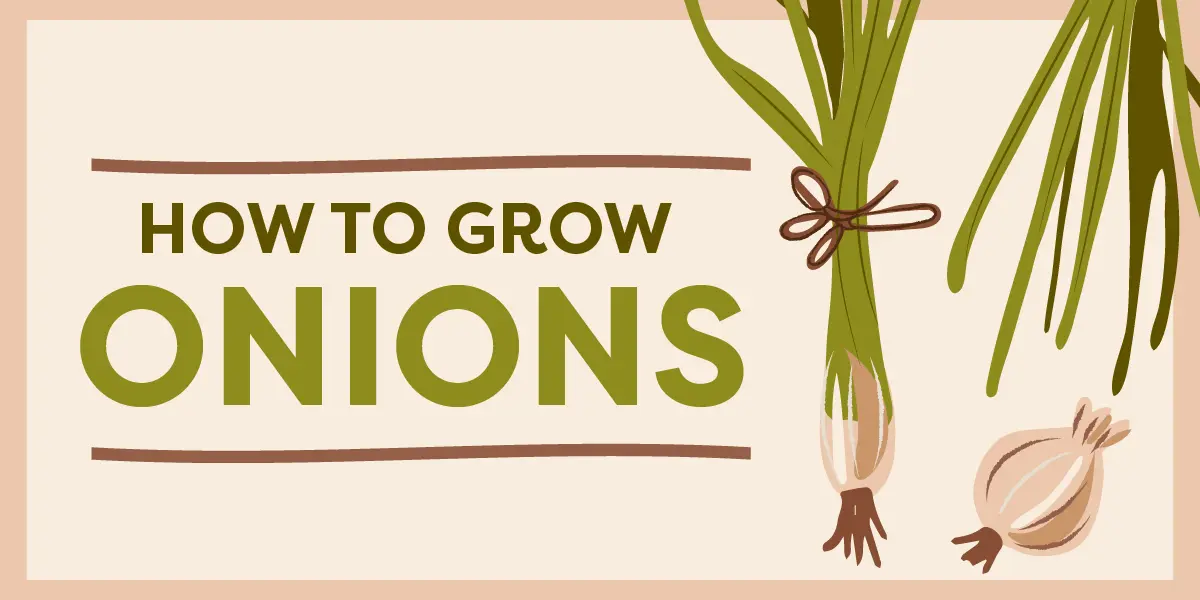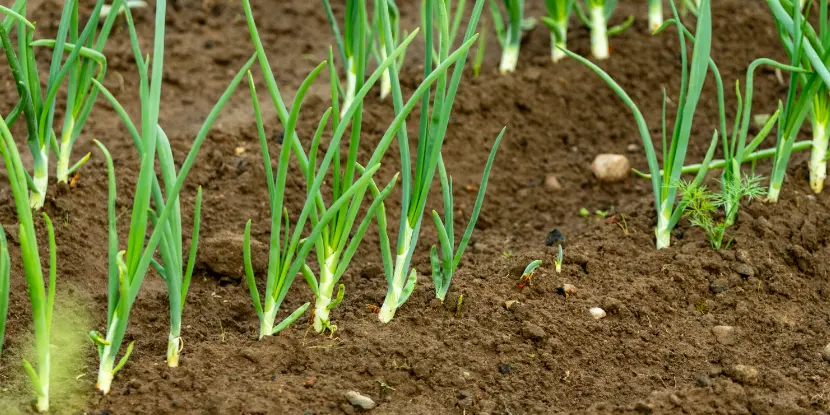Green onions, also known as scallions or spring onions, originated in Central Asia. Records indicate their culinary use in ancient civilizations, including the Egyptians and the Chinese.
European settlers introduced them to America in the 17th century, where they quickly became a staple in regional cuisines.
Popular American dishes include:
- Southern collard greens are often cooked with green onions for contrasting flavor.
- Potato salad with diced green onions added for crispness and subtle onion flavor.
- Tex-Mex tacos: Green onions are frequently used as a garnish alongside toppings like cilantro and lime.
- Omelets and frittatas: These breakfast dishes often include chopped green onions, enhancing the taste and presentation of the meal.
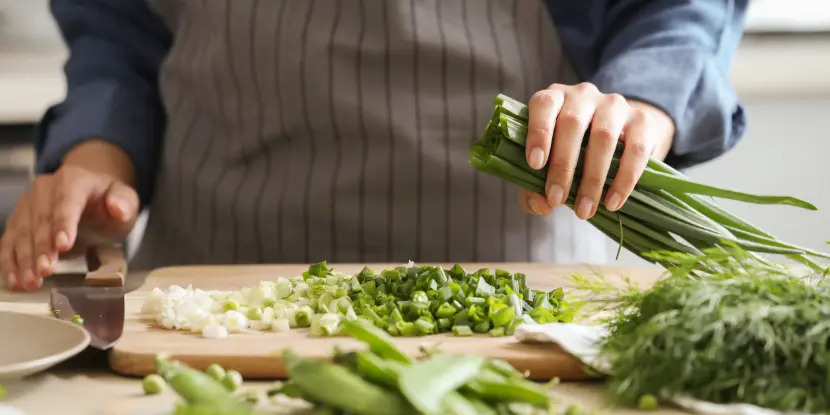
Green onions have been used in international cuisine for centuries.
Cultivation in California
Green onions are notably easy to grow in Southern California’s mild climate and ample sunlight.
The extended growing season allows for year-round cultivation. Green onions thrive in well-draining soil and require only moderate watering, making them well-suited to the area’s often arid conditions.
Their relatively low maintenance and quick harvest time — typically within 4 to 8 weeks — make them ideal for novice gardeners.
Green Onions Vs. “Regular” Onions
- Green onions are harvested before the bulb fully forms. Regular onions are mature with fully developed bulbs.
- Green onions have a milder, more delicate flavor than regular onions.
- The entire green onion plant is edible. Only the bulb is consumed with regular onions.
- Green onions are often added to dishes raw for their distinctive taste and texture. Regular onions are cooked with other ingredients or used in cooking stocks and sauces.
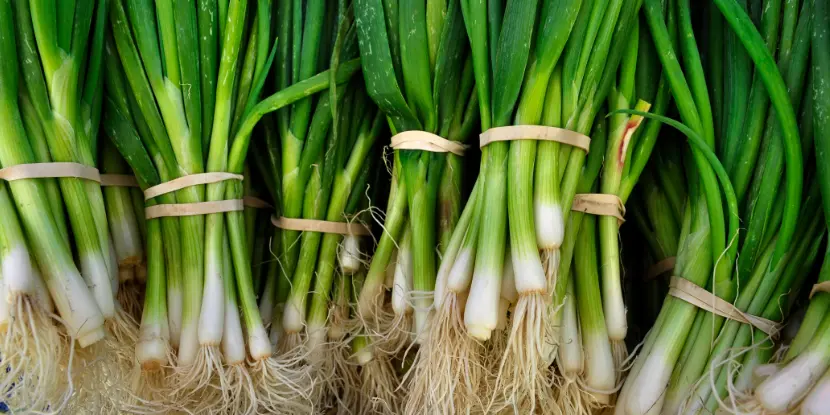
You can start your onion garden with cuttings from fresh, store-bought green onions.
Growing Green Onions from Cuttings
Select green onion bunches with firm white bottoms and dark green tops. Avoid slimy or wilted specimens.
- Trim off the root end of the green onion, leaving approximately 1 inch. This will serve as your cutting.
- Place the cutting in a glass or jar with water covering the root end. Set the jar on a sunny windowsill.
- Change out the water every day to prevent bacterial growth.
- After about a week, small roots should form at the base of the cutting.
- Once the roots are about 2 inches long, transplant the cuttings into soil.
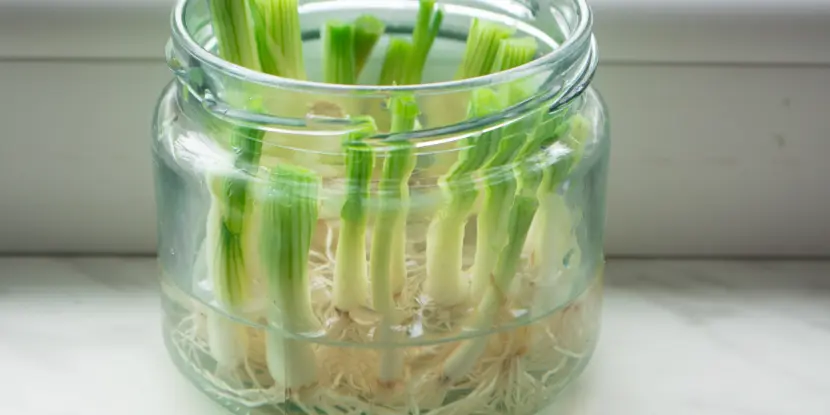
Green onion cuttings in a jar of water.
Transplanting Green Onions
- Select a spot in your garden or a container that receives full sunlight for most of the day. The soil should drain well.
- Loosen the soil to a depth of 6 inches. Mix in compost or organic matter to enrich the soil and improve drainage.
- Make small holes in the prepared soil, spaced about 2 inches apart. This gives each green onion room to grow.
- Carefully place the cuttings in the holes, burying them up to the base of the green tops. Spread the roots well.
- After transplanting, water the area thoroughly to settle the soil around the roots.
- Apply a thin layer of mulch around the plants to retain moisture and suppress weeds (optional).
Light
- Green onions need at least 6 to 8 hours of direct sunlight daily for healthy growth.
- They also tolerate bright, indirect light conditions, albeit with slower growth.
- Fluorescent or LED grow lamps can supply adequate light indoors.
Temperature
- Ideal temperatures range from 40°F to 75°F.
- Extreme heat or cold may slow growth or cause wilting. Onions usually recover once temperatures return to the optimal range.

Illustration of the root systems of green onions.
Soil
- Green onions tolerate many soil types, but growth is best in well-draining, loamy soil.
- A slightly acidic pH level between 6.0 and 6.5 promotes healthy growth.
Watering
- Keep the soil consistently moist but not soggy.
- Allow the top inch of soil to dry out before watering again.
- During hot, dry weather, green onions may need more frequent watering.
Fertilizing
- Green onions are light feeders and don’t require much fertilizing.
- A single application of a balanced fertilizer at planting time is usually sufficient for the entire growing season.

Green onions can grow indoors, as long as they get adequate light.
Pests & Diseases
- Onions are generally resistant to pests and diseases.
- If necessary, treat with an organic insecticide or fungicide.
- Avoid overcrowding plants, as this can increase the risk of disease transmission.
Harvesting
- Leaves are ready for harvest when they reach 6 inches high.
- Cut leaves with scissors or gently pull them from the plant.
- Avoid removing more than one-third of the plant at a time to allow for continued growth.
- Harvest regularly to encourage new growth and a continuous supply of fresh green onions for your kitchen.
Companion Planting
- When paired with suitable plants, onions offer natural pest control and enhance garden health and productivity.
- Their strong scent deters common pests like aphids and carrot flies.
- Green onions coexist with various garden vegetables without competing for nutrients.
- Avoid planting onions near legumes (such as peas and beans) or asparagus; they may inhibit each other’s growth.
Additional Tips & Tricks
- Stagger your plantings every two to three weeks for a continual harvest. This method prolongs the availability of fresh green onions throughout the growing season.
- Use scissors instead of pulling the green onions from the ground when harvesting. This minimizes damage to the plant and encourages regrowth.
- To extend the shelf life of harvested green onions, store them upright in a glass of water in the refrigerator, covering the tops loosely with a plastic bag.
- Practice crop rotation to prevent soil nutrient depletion and reduce the risk of pests and diseases.
- Apply organic mulch to retain soil moisture and suppress weeds. To avoid rot, it should not touch the green tops.
- Before planting, consider testing your soil to understand its nutrient composition. This information can guide you in selecting the appropriate fertilizer or amendments for optimal growth.
FAQs: Growing Green Onions
Q: How often can I harvest my green onions?
Every 3-4 weeks, depending on growth conditions. Avoid harvesting more than one-third of the plant at a time.
Q: Can I grow green onions indoors?
Yes, as long as they have adequate sunlight or supplemental lighting and proper moisture levels.
Q: Do I need to thin out my green onion plants?
No, not if you space them 2 inches apart during transplanting. However, if you notice overcrowding or resource competition among the plants, you may have to thin them out.
Q: What if my onions stop growing?
Check the growing conditions, such as sunlight, temperature, and moisture levels. Onions are sensitive to extreme temperatures and waterlogged soil. Adjust these factors accordingly to promote growth.
Q: Can I regrow green onions from store-bought ones?
Yes, you can! Cut off the bottom white part of the green onion and place it in a glass of water on a sunny windowsill. Change the water daily until roots form, then transplant into soil for continued growth.
Q: Can I use regular onions instead of green onions?
They have distinct flavors and uses in cuisine. Green onions have a mild, fresh taste, perfect for raw dishes, while regular onions are typically cooked. However, you can use regular onions as a substitute in dishes that call for green onions. Just remember to adjust the amount.
Q: What are the signs that my green onions are ready for harvest?
You can harvest your green onions when the leaves reach a height of 6 inches. Healthy green onions will have vibrant green tops and firm stems.
Q: How can I prevent weeds from overtaking my green onion plants?
Apply a layer of organic mulch around your green onion plants to suppress weed growth. Regularly inspect the garden bed and manually remove any weeds that appear.

